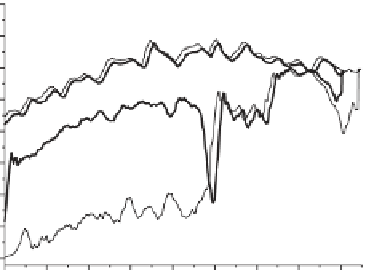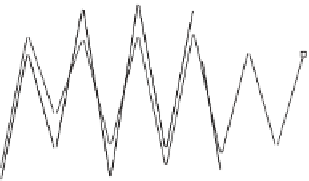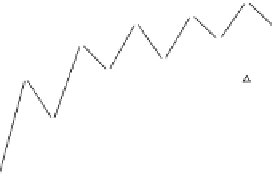Biomedical Engineering Reference
In-Depth Information
8
7
6
5
4
3
2
Layer 9 (PAH)
Layer 8 (PAA)
1
0
0,0
0,2
0,4
0,6
0,8
1,0
1,2
1,4
1,6
Fibre distance (mm)
Figure5.11
Forcetracesfromthewashingstepofafibretreatedwith8and9layersof low
molecularmassPAH/PAAadsorbedatpH5,withabackgroundelectrolyteconcentrationof
0.01MNaCl,andwashedunderthesameconditions.Thelowercurvesshowtheforcetrace
when thefibrewas immersed (advancing), and theupper curves showthe force tracewhen
thefibrewaswithdrawn(receding).ThefibrewastreatedwithPEMtoadepthof0.9mmand
washedtoadepthof1.7mm.Datafrom(41).
110
100
90
80
70
60
pH 7.5/3.5 HMw
pH 7.5/3.5 LMw
pH 5/5 LMw
pH 7.5/7.5 LMw
50
40
30
20
0
2
4
6
8
10
12
Number of layers
Figure 5.12
The advancing contact angle as a function of the number of layers on an
individual fibre treated with PAH/PAA (15000/8000) (LM
w
) at pH 5, 7.5/3.5, and 7.5/7.5
andwithPAH/PAA(70000/240000 (HM
w
) atpH7.5/3.5. Theadsorptionwascarriedout at
0.01MNaCl.Datafrom(35,41).
that there was a significantly larger difference in advancing contact angle depending on
the polyelectrolyte in the most external layer for the pH 7.5/3.5 adsorption strategy than
for the pH 7.5/7.5 strategy.
Since it is well known that the contact angle is influenced by the first nm of a polymer
film, the advancing contact angle can be used to estimate the difference in structure of
the PEMs formed. Small differences in contact angle may indicate very thin individual



























































Search WWH ::

Custom Search